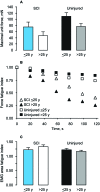Age at spinal cord injury determines muscle strength
- PMID: 24478643
- PMCID: PMC3899581
- DOI: 10.3389/fnint.2014.00002
Age at spinal cord injury determines muscle strength
Abstract
As individuals with spinal cord injury (SCI) age they report noticeable deficits in muscle strength, endurance and functional capacity when performing everyday tasks. These changes begin at ~45 years. Here we present a cross-sectional analysis of paralyzed thenar muscle and motor unit contractile properties in two datasets obtained from different subjects who sustained a cervical SCI at different ages (≤46 years) in relation to data from uninjured age-matched individuals. First, completely paralyzed thenar muscles were weaker when C6 SCI occurred at an older age. Muscles were also significantly weaker if the injury was closer to the thenar motor pools (C6 vs. C4). More muscles were strong (>50% uninjured) in those injured at a younger (≤25 years) vs. young age (>25 years), irrespective of SCI level. There was a reduction in motor unit numbers in all muscles tested. In each C6 SCI, only ~30 units survived vs. 144 units in uninjured subjects. Since intact axons only sprout 4-6 fold, the limits for muscle reinnervation have largely been met in these young individuals. Thus, any further reduction in motor unit numbers with time after these injuries will likely result in chronic denervation, and may explain the late-onset muscle weakness routinely described by people with SCI. In a second dataset, paralyzed thenar motor units were more fatigable than uninjured units. This gap widened with age and will reduce functional reserve. Force declines were not due to electromyographic decrements in either group so the site of failure was beyond excitation of the muscle membrane. Together, these results suggest that age at SCI is an important determinant of long-term muscle strength, and fatigability, both of which influence functional capacity.
Keywords: motoneuron death; motor axon sprouting; muscle fatigue; muscle reinnervation; muscle strength; muscle use.
Figures



References
Grants and funding
LinkOut - more resources
Full Text Sources
Other Literature Sources
Research Materials
Miscellaneous

